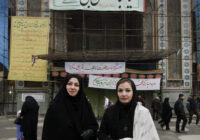Iranian-Americans are some of the most successful immigrant communities in the US.
Iranian-Americans are “one of the most successful immigrant groups in our country’s contemporary history,” said the newly elected US President Donald Trump in a statement released marking the Iranian New Year, or Nowruz, in March. It was a halfhearted gesture considering his ensuing political tirades against Iran since he stepped into office only months ago. The National Iranian American Council (NIAC) lambasted the president for his ingenuity by citing an ancient Persian proverb: “Empty words disgrace the one who speaks them, like serving a walnut shell without the nut.”
According to a report by the Small Business Administration, Iranians rank in the top 20 of immigrant groups with the highest rate of business owners at over 20%. While many immigrants came to the United States for greater economic opportunities, Iranians largely came after the 1979 revolution for political and social reasons. Iranians also make up some of the most educated immigrants. Over 50% of Iranians have at least a bachelor’s degree, far surpassing the national average of under 30%. There is no dispute that Iranians are some of the most successful immigrants in the US, a truth that even President Trump could not deny.
While the Trump administration’s controversial travel ban was intended to prevent “radical Islamists” from entering the US, many Iranian immigrants fled Iran for that exact reason. Ayatollah Ruhollah Khomeini led a revolution that overthrew the late shah, Mohammed Reza Pahlavi, after decades of authoritarian rule. In its place would rise an Islamic Republic governed by a religious supreme leader who oversees the president and parliament.
The US became a safe haven for former government officials under the shah — political dissidents, intellectuals, religious minorities and ordinary Iranians escaping life under strict Islamic rule. Even before the revolution, these same groups fled Iran en masse, either escaping repression by the shah that had peaked in the last years of his reign or anticipating turmoil as the uprisings escalated. Only a year after the revolution, the number of Iranian immigrants spiked to 130,000, up from only 24,000 just 10 years earlier.
Of these immigrants, over 70% of them had arrived in the US in the second half of the 1970s. From 1990 to 2000, the number of Iranian immigrants increased by another 34%. These numbers are likely low estimates, considering that many Iranians do not file census, and that the ones who do often select the “white/caucasian” category because they are neither Arab nor consider themselves Asian. Despite this, the statistics still reveal a significant increase in the number of Iranians immigrating to the US in the midst and aftermath of the revolution.
Life in the Islamic Republic is difficult for many Iranians. Islamic laws dictate public life: Unrelated women and men are prohibited from intermingling, and women are forced to cover their hair and wear the mantoo, a shapeless knee-length jacket. Alcohol is banned as are many films and books that have been deemed as “un-Islamic” because of the country’s strict censorship. While Iranians can withdraw into the safe confines of their private homes barricaded by tall solid fences and heavily-curtained windows, it is hard to avoid the imposition of religion in everyday public life. It should come as no surprise that tens of thousands left — and continue to leave — Iran for countries that offer more freedom, like the US.
Safe Haven
The US has become a safe haven for many Iranians and a front for protesting the Islamic Republic. It houses multiple prominent human rights organizations, least of which include the NIAC, which has played a leading role in promoting the Iran nuclear deal and most recently the battle to repeal Trump’s Muslim ban. The Center for Human Rights in Iran has also taken advantage of greater press freedoms in the US to criticize the Islamic Republic’s treatment of minorities and women and the arbitrary detention of political dissidents. It is as if Iranian-Americans have taken a page from Khomeini’s playbook: He had mobilized Iranians against the shah by disseminating tapes of his fiery sermons while in exile to dissenters inside the country.
Resistance also takes shape in the form of art. Despite reform-minded presidents like Mohammad Khatami and Hassan Rouhani’s efforts to relax restrictions on the arts in Iran, artists are still constrained by Islamic laws that prevent them from being overly politically expressive or from showing women without the hijab, being romantically involved with men or violating Islamic values in any way. Indeed, the depiction of women is often a telltale of whether an Iranian film was actually produced inside the country or outside of it. Some have managed to circumvent censorship by employing extreme creative licenses that require creative interpretation by the audience. Art in this form is an act of defiance and resistance in the Islamic Republic, but it can have a limited scope.
Iranian-Americans, however, are not bounded by these restrictions. Los Angeles has emerged as the epicenter of Iran’s art scene, from film, music and the like. Many Iranian artists’ music videos are filmed in LA, where lyrics can mean anything and women can wear anything — or nothing, which seems to be a cross-cultural feature in all rap videos. The country’s most beloved singer, Googoosh, is actually barred from re-entering Iran because of her lyrics, punctuated by love and freedom. At the Muslim ban’s inception, she was also barred from returning to the US after giving a performance in London. She has since returned to her long-time home, “Tehrangeles.” Art is a powerful instrument of resistance, and the US offers an unrestricted theater for Iranian artists to fully express themselves.
An Exception or the Norm?
Iranians are the masterminds behind some of America’s favorite technology, and it is difficult to imagine a country without them. Tehran-born Salar Kamangar was only the seventh person to join YouTube in its nascency and rose to become its CEO. Expedia experienced its greatest expansion under the new CEO Dara Khosrowshahi, also born in Tehran.
Children of Iranian immigrants continue to uphold the success of the first generation. Where would we be without the technology to swipe right for love? You can thank Sean Rad for your awkward first dates, bad hook-ups or for finding your soulmate on Tinder. Pierre Omidyar, another second-generation Iranian-American, introduced the US to one of the first e-commerce platforms when he founded the multibillion dollar corporation eBay. Dare I mention how our teenage years would have been spent without Shahram Dabiri, the lead producer of World of Warcraft? Other Iranian-Americans include Arash Ferdowsi, co-founder of Dropbox, Shayan Zadeh, founder of Zoosk, Mehrdad Nikoonahad of Nikoo Technology and many, many more.
Iranians also hold remarkably high executive positions throughout the tech industry. Least of which include Ali Rowghani, COO of Twitter, Farzad Nazem, the longest-serving executive and former CTO of Yahoo, and Amid Kordestani, the former vice president of Google.
Even more remarkable are Iranian women who have overcome the American STEM (science, technology, engineering and mathematics) gap. Anousheh Ansari was born in Mashhad and moved to the US with her family as a teenager, just a few years after the revolution. Not only is Ansari an astronaut, but she is also the co-founder of Prodea Systems and a revered engineer. She accepted an Oscar on the Iranian film director Asghar Farhadi’s behalf, who boycotted attending the ceremony in protest of the Muslim ban.
Maryam Mirzakhani, a mathematician, became the first woman to win the Fields Medal, America’s top mathematics prize. Pardis Sabeti, an Iranian-American who currently serves as a professor at Harvard University, headed a research team that made groundbreaking discoveries on the Ebola virus that plagued West Africa only a few years ago. These women are not only role models for Iranian women, but all women in the US who aspire for STEM careers.
Iranians also have a constant presence in American writing, from journalism to academia and literature. Jason Rezaian became the most well-known Iranian-American journalist after he was convicted of espionage for appearing on CNN’s Parts Unknown. He has since been released and continues to write for The Washington Post. He is only one among many Iranians to open a window into the region for their viewers and readers. Others include journalist veteran Rudi Bakhtier and rising star Azadeh Moaveni.
Reza Aslan, a Catholic convert and born-again-Muslim, rose to prominence after a Fox News host attacked him for writing a book on the life of Jesus. Aslan has written multiple illuminating books on Islam, and most recently hosted the CNN show Believer, where he immersed himself in religions around the world. He tirelessly works to combat Islamophobia and to open Americans up to different religious beliefs.
Nader Hashemi, who may not have as much name recognition as Aslan, is still revered among the academic community for his research on sectarianism and policy prescriptions for it. After having her novel, Reading Lolita in Tehran, on The New York Times bestseller list for 117 weeks in 2003, Azar Nafisi continues to not only be an acclaimed writer, but has also adopted an advisory role for US foreign policy toward Iran. Nafisi has served on the board of trustees for Freedom House and as a guest lecturer at The Foreign Policy Institute at Johns Hopkins University.
Make America Great, Again
Even though US courts blocked the Muslim ban, the Trump administration is likely to continue restricting Iranian immigrants from obtaining visas to live, study or work in the US, possibly depriving the country of a desperately needed generation of hard workers, tech geniuses, scientists and global thinkers.
Iranian-Americans are not a danger to the US — they are an asset. They have contributed to virtually every sector of the American economy and society and continue to play a prominent role in shaping US foreign policy. Trump and the supporters of restricting the flow of Muslim immigrants are severely misguided in their logic. Iranians should not be held responsible for the actions of their government and become collateral damage in the process. Indeed, they voted overwhelming for the progressive incumbent Hassan Rouhani in the recent presidential elections that also doubled as a referendum on the nuclear deal and rapprochement with the West. Trump would be doing a disservice to his own country by continuing to unfairly target Iranians in his campaign to “Make America Great Again.” He doesn’t need to look further than Tehrangeles to start getting the job done.
The views expressed in this article are the author’s own and do not necessarily reflect Fair Observer’s editorial policy.
Photo Credit: Melpomenem
Support Fair Observer
We rely on your support for our independence, diversity and quality.
For more than 10 years, Fair Observer has been free, fair and independent. No billionaire owns us, no advertisers control us. We are a reader-supported nonprofit. Unlike many other publications, we keep our content free for readers regardless of where they live or whether they can afford to pay. We have no paywalls and no ads.
In the post-truth era of fake news, echo chambers and filter bubbles, we publish a plurality of perspectives from around the world. Anyone can publish with us, but everyone goes through a rigorous editorial process. So, you get fact-checked, well-reasoned content instead of noise.
We publish 3,000+ voices from 90+ countries. We also conduct education and training programs
on subjects ranging from digital media and journalism to writing and critical thinking. This
doesn’t come cheap. Servers, editors, trainers and web developers cost
money.
Please consider supporting us on a regular basis as a recurring donor or a
sustaining member.
Will you support FO’s journalism?
We rely on your support for our independence, diversity and quality.









